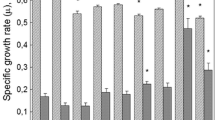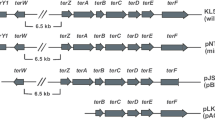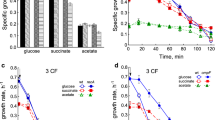Abstract
The production of reactive oxygen intermediates (ROI) and reactive nitrogen intermediates (RNI) is an important host defense mechanism in response to infection by Mycobacterium tuberculosis. A variety of genes have been implicated in resistance to ROI and RNI, including noxR1. However, studies in Mycobacterium avium, an important pathogen among nontuberculous mycobacteria, are limited. We aim to investigate the role of a novel gene cloned from M. avium with high similarity to noxR1, noA, in resistance against RNI and ROI in M. tuberculosis. After subcloning noA into vector for expression in E. coli, we performed survival rate analysis in the bacteria transformed with noA (pET-noA) and without noA (pET-his) after exposure to nitrosative stresses by S-nitrosoglutathione (GSNO) and sodium nitrite, and oxidative stresses by H2O2. Compared with pET-his, the survival rate of pET-noA was 1 log10-fold higher after exposure to GSNO and sodium nitrite. We observed 1 log10-fold, 2 log10-fold and 3 log10-fold higher survival rate in pET-noA than pET-his after exposure to H2O2 for 3, 6 and 9 h, respectively. With the combined treatment of H2O2 and GSNO, we found more than 2 log10-fold increase in survival rate in pET-noA comparing with pET-his, suggesting a possible synergistic effect. In summary, noA gene cloned from M. avium has been shown to protect E. coli from both RNI and ROI.




Similar content being viewed by others
References
Chan J, Xing Y, Magliozzo RS, Bloom BR (1992) Killing of virulent Mycobacterium tuberculosis by reactive nitrogen intermediates produced by activate murine macrophages. J Exp Med 175:1111–1122
Chan ED, Chan J, Schluger NW (2001) What is the role of nitric oxide in murine and human host defense against tuberculosis? AmericCurrent knowledge. Am J Respir Cell Mol Biol 25:606–612
Du Q, Lehavi D, Faktor O, Qi Y, Chejanovsky N (1999) Isolation of an apoptosis suppressor gene of the Spodoptera littoralis nucleopolyhedrovirus. J Virol 73:1278–1285
Early J, Fischer K, Bermudez LE (2011) Mycobacterium avium uses apoptotic macrophages as tools for spreading. Microb Pathog 50:132–139
Ehrt S, Shiloh MU, Ruan J, Choi M, Gunzburg S, Nathan C, Xie Q, Riley LW (1997) A novel antioxidant gene from Mycobacterium tuberculosis. J Exp Med 186:1885–1896
Griffith DE, Aksamit T, Brown-Elliott BA, Catanzaro A, Daley C, Gordin F, Holland SM, Horsburgh R, Huitt G, Iademarco MF, Iseman M, Olivier K, Ruoss S, von Reyn CF, Wallace RJ Jr, Winthrop K, ATS Mycobacterial Diseases Subcommittee, American Thoracic Society, Infectious Disease Society of America (2007) An official ATS/IDSA statement: diagnosis, treatment, and prevention of nontuberculous mycobacterial diseases. AmJ Respir Crit Care Med 175: 367–416
Henry MT, Inamdar L, O’Riordain D, Schweiger M, Watson JP (2004) Nontuberculous mycobacteria in non-HIV patients: epidemiology, treatment and response. Eur Respir J 23:741–746
Kurtz S, McKinnon KP, Runge MS, Ting JP, Braunstein M (2006) The SecA2 secretion factor of Mycobacterium tuberculosis promotes growth in macrophages and inhibits the host immune response. Infect Immun 74:6855–6864
Lee WL, Gold B, Darby C, Brot N, Jiang X, de Carvalho LP, Wellner D, St John G, Jacobs WR Jr, Nathan C (2009) Mycobacterium tuberculosis expresses methionine sulphoxide reductases A and B that protect from killing by nitrite and hypochlorite. Mol Microbiol 71:583–593
Nathan C, Shiloh MU (2000) Reactive oxygen and nitrogen intermediates in the relationship between mammalian hosts and microbial pathogens. Proc Natl Acad Sci USA 97:8841–8848
O’Brien L, Carmichael J, Lowrie DB, Andrew PW (1994) Strains of Mycobacterium tuberculosis differ in susceptibility to reactive nitrogen intermediates in vitro. Infect Immun 62:5187–5190
Ruan J, St John G, Ehrt S, Riley L, Nathan C (1999) noxR3, a novel gene from Mycobacterium tuberculosis, protects Salmonella typhimurium from nitrosative and oxidative Stre. Infect Immun 67:3276–3283
Stamler JS (1994) Redox signaling: nitrosylation and related target interactions of nitric oxide. Cell 78:931–936
Venketaraman V, Dayaram YK, Amin AG, Ngo R, Green RM, Talaue MT, Mann J, Connell ND (2003) Role of glutathione in macrophage control of mycobacteria. Infect Immun 71:1864–1871
World Health Organization (2015) Global tuberculosis report 2015
Acknowledgements
This work was supported by the National Natural Science Foundation of China (81260245) and the Guangxi Natural Science Foundation (2015GXNSFAA139077).
Author information
Authors and Affiliations
Corresponding author
Ethics declarations
Conflict of interest
The authors have declared no conflict of interest.
Rights and permissions
About this article
Cite this article
He, S., Wang, A., Ning, X. et al. The protective effect of a novel antioxidant gene from Mycobacterium avium against nitrosative and oxidative stress in E. coli . World J Microbiol Biotechnol 33, 127 (2017). https://doi.org/10.1007/s11274-017-2294-6
Received:
Accepted:
Published:
DOI: https://doi.org/10.1007/s11274-017-2294-6




